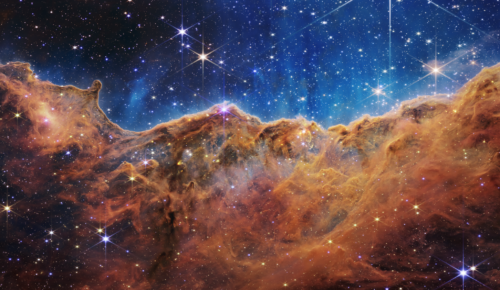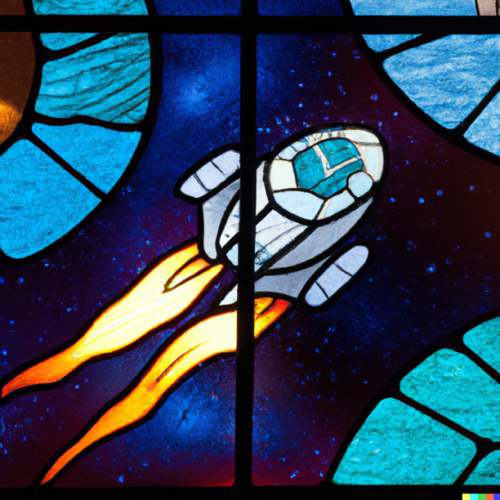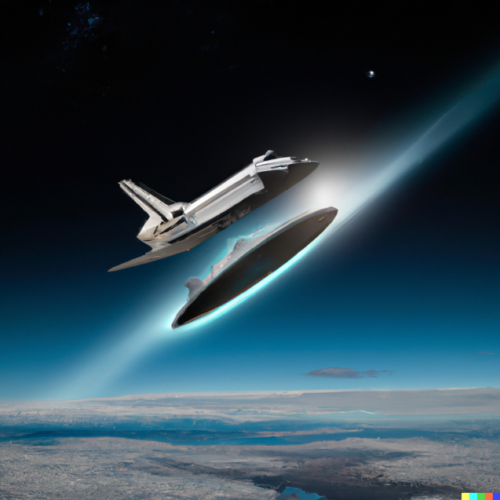

For as long as humankind has been around, we have been enamoured with the mystifying allure of the night sky and its endless possibilities. In the modern day and age, we have seen this interest grow exponentially from a simple glance upwards, to incredible innovations in technology that allow us to traverse this impossibly massive frontier. Amidst a tough economic landscape and rising geopolitical tensions, it may not seem apparent why space exploration and associated scientific research remains necessary. Not only do space exploration and associated scientific research lead to monetary benefits; but they also contribute to technological progress, strengthen the global economy, foster international cooperation and last but not least, inspire and fulfil the intrinsic thirst for knowledge that drove these efforts in the first place. The by-products of space technology innovation have accelerated the pace of our technological advancements and optimised the efficiency of capital inputs here on Earth. In terms of economic output, space exploration and discovery have a tangible and material impact. Despite the naysayers, space exploration and discovery are not simply about faraway planets and rockets; they are necessary areas to put funding towards, both for their short and long-term impacts on our planet and its people.

Source: NASA
While the space race started as a contest between two superpowers, space exploration and discovery have now become a global phenomenon, with 90 nations currently operating in space. Notably, reduced costs mean that space exploration is no longer limited to the public sector. Many private-sector companies are now investing in space programmes, seeking potentially lucrative business opportunities. It is estimated that there are now around 5,000 investors involved in the space industry. The Space Foundation’s The Space Report 2022 estimates that the space economy was worth $469 billion in 2021 – a 9% increase from the previous year.
Despite the importance of space exploration, the barriers to entry remain very high. Space exploration entails significant economic costs due to the complexity and high technology involved in developing and launching spacecraft, conducting scientific research, and supporting human missions. Additionally, return on investment is not always guaranteed and failed space missions are extremely expensive. NASA estimates that the average space shuttle mission costs $450 million. Every delay of a shuttle mission costs Americans about $1.3 million per day. Some argue that we should tackle our most pressing issues on Earth before investing in trips to the Moon and Mars. This argument, however, presents a falsehood as there are many economic benefits, both intrinsic and extrinsic, to space exploration and the associated scientific research.
Firstly, space exploration has resulted in significant innovations, contributing to the creation of GPS, solar panels and cancer therapy. (Benefits Stemming from Space Exploration, 2013, p. 1). Since 1976, NASA has recorded over 2,000 spinoff technologies as a result of its research, including a ventilator for COVID-19 patients which was developed in just 37 days (Inclán et al., 2020). These innovations contribute greatly to the global economy through increased productive efficiency and better health and educational outcomes, the latter of which is further exemplified through a more technically educated labour force. Investment in the Apollo program during the 1960s directly correlated with higher levels of earned PhDs in STEM fields (Benefits Stemming from Space Exploration, 2013, p. 9).
Secondly, increased space capabilities better equip humanity for prevailing problems on Earth. For example, an improved ability to observe Earth and monitor weather patterns allows us to better predict natural disasters, thus minimising the economic losses from these events and saving lives in the process. Satellites also provide data and statistics that are vital for monitoring climate change and tracking environmental quality. This is especially significant in our fight to slow down climate change, as it helps us to better understand the impact of human activities on the environment and develop effective strategies towards environment conservation.
Thirdly, in these divisive times, space exploration encourages greater international cooperation, strengthening the global economy. The International Space Station (ISS) is a prime example of international cooperation in space exploration. It serves as a collaborative platform for scientific research and promotes knowledge sharing and international camaraderie, as astronauts from different countries work together on shared missions and experiments.
Finally, there are economic benefits of public investment in space exploration. For example, in NASA’s first economic impact report in 2020, it was found that NASA generated “more than $64.3 billion in total economic output during fiscal year 2019, supported more than 312,000 jobs nationwide, and generated an estimated $7 billion in federal, state, and local taxes throughout the United States” (Inclán et al., 2020). The study found that the agency’s Moon to Mars initiative produced over 69,000 jobs nationwide, over $14 billion in economic output, and $1.5 billion in tax revenue, accounting for nearly a quarter of NASA’s economic impact.
Scientific research and space innovation are not, however, merely a zero-sum game of financial costs and benefits. Such research leads to technological development and is a cycle of continual progress. This work allows new phenomena to be understood, it allows new techniques to be developed, or improved upon, and it paves the way for new technologies that can fundamentally change the future course of the human race.
But what are some big examples of this?
The scientific pursuit of knowledge and attempts to increase humanity’s understanding of the universe has led to incredible developments in technology. The Event Horizon Telescope is a worldwide scientific undertaking, using a global network of radio telescopes. The measurements from the various observatories in the Event Horizon Telescope combine to form a virtual earth-sized telescope, and have allowed us to view a black hole at the centre of our galaxy. While the existence of black holes has been predicted since Einstein’s famous theory of general relativity, this project gave humanity an actual image of a black hole, which took the world by storm.
On the subject of telescopes, the James Webb Space Telescope, launched into space in 2021 under a partnership between NASA and some of their international equivalents, allows us to view ancient galaxies across the universe, as well as image new stars and aid scientists in the search for life on other planets. Aside from the myriad of scientific discoveries gleaned from an endeavour as exciting and unique as the James Webb Telescope, the project itself required significant innovation and the development of novel technologies “ranging from optics to detectors to thermal control systems”. It is almost impossible to measure how such technologies will continue to be developed both for space exploration and in other fields, with each new advancement building upon the last.
Scientists are also constantly making progress on nuclear fusion, which, once mastered, could lead to such incredibly rapid increases in energy consumption that it is likely to lead to the fastest-ever developments of humanity – in the future, this technology has the potential for allowing emissions-free energy to power the entire planet, and perhaps even powering large space vessels for long-distance space travel. While it is often joked that a fully functional energy generator using nuclear fusion always seems to be about thirty years away, developments in this field will ultimately revolutionise the rules of the game for humanity’s technological progress.

A Journey Into Space – This image was generated using DALL·E 2, an AI system by OpenAI.
Huge scientific projects are one thing, but there are also plenty of less conspicuous examples of how space science has contributed to the development of extremely useful technologies. Space research continues to change the world in all fields, from human health, to engineering, to the future of energy production – space-focused projects have contributed to significant developments that affect all of us in some way.
NASA’s work has helped with many medical endeavours such as reducing the cost of creating prosthetic limbs and making it easier for doctors to find cancers in patients. NASA’s research into monitoring the vital signs of their astronauts led to the development of the implantable insulin pump, creating new opportunities to change the lives of people living with diabetes. An eye-tracking device used to monitor the effects of weightlessness on astronauts has been adapted and now contributes to increasing the safety of laser eye surgeries. They’ve also contributed significantly to the development of scratch-resistant lenses, revolutionising how the majority of sunglasses and corrective lenses are made today.
Materials developed by NASA that are able to withstand extreme heat and cold, while obviously essential for space exploration, have been adapted to help firefighters down on earth. NASA’s development of shock absorbers has aided developments in protecting buildings (and therefore saving human lives) from the dangers of earthquakes. Additionally, while there is a clear need for astronauts on board space stations to use recycled and filtered water, back down on Earth there are still billions of people who do not have access to a regular supply of clean drinking water. NASA’s rapid advancements in water filtration can be critical to aiding humanity in providing clean water to those in need.
As society shifts towards sustainability and the generation of renewable energy continues to gain practical and widespread use, space scientists’ significant contributions toward the development and improvement of photovoltaic cells and new methods for capturing energy from our sun remain of utmost importance.
These are just some examples of the plethora of contributions from space research to the development of technologies that are used in otherwise unrelated fields; contributions that can change lives every day, all around the world.

Exploration and Technology – This image was generated using DALL·E 2, an AI system by OpenAI.
Apart from the tangible and monetary benefits of space research and exploration, the reasons why we explore stretch far beyond that. The intangible benefits of fulfilling curiosity, pushing boundaries of our scientific and technical limits, and fostering a peaceful connection with other nations are amongst the many which are unquantifiable, yet a vital consideration when we allocate funding towards it. The human desire to explore and challenge the boundaries of what we know has provided many benefits to our society, as illustrated.
The opportunities for global collaboration will highlight our common interests and provide a global sense of community. Working with other countries can provide access to various competitive advantages and shared costs. The result of this is faster progress and greater speed of innovation that we may not have been able to achieve on our own. This collaboration can also bring diplomatic benefits, and these existing relationships with other nations can prove to be valuable in ways we cannot predict with certainty.
Furthermore, space exploration calls for specialists in diverse industries, including those working in data science, mapping, agriculture and mining. The renewed global efforts into space will inspire countless people of our generation to pursue related fields and STEM subjects, which has various benefits for our nation. Not only that, but with the push for diversity in many of these endeavours, we will stand to see increased representation in these boundary-pushing roles, and those adjacent to them. The achievements in research serve as a catalyst for educational initiatives, promoting scientific literacy and fostering a culture of innovation and excellence.
Additionally, space research contributes to us understanding our own planet better. Satellites provide vital data to manage our resources, study the change in climate, track deforestation, and predict natural disasters – immensely valuable information for those working towards the preservation of our environment. NASA’s Double Asteroid Redirection Test (DART) is a mission seeking to deflect deadly asteroids that may collide with the Earth. It was proven successful that it is possible to change an asteroid’s motion in space, and this has far-reaching implications for the future endurance of humankind. Despite the lack of imminent threat, these efforts not only allow us to understand how to preserve our own planet from an internal climate change perspective, but also how to potentially ward off future external threats that have devastating and fatal implications.
At the core of it all, space exploration is driven by a human thirst for knowledge and curiosity for the unknown. It is a testament to our ingenuity and the relentless quest for understanding the universe and our place within it. By nurturing this curiosity and providing opportunities for action, space research can shape the minds and aspirations of the generations to come, increasing careers in STEM and furthering scientific progress. Where we push boundaries is where we see the greatest progression. This curiosity compels us to overcome technological and scientific challenges which may seem insurmountable, driving innovation. This paves the way for advancements in various fields, including aerospace engineering, robotics and medicine. The impacts these may have are unquantifiable, but one thing is for certain – in our pursuit for knowledge and insight, we are bound to benefit in ways we may not even foresee.
Space research and exploration is an undeniably fascinating area, and the opportunities are endless. Our progress in the last 50 years has been exponential, and it only becomes more necessary that we prioritise this innovation in the years to come. It is a frontier where international partnerships are paramount to our continued achievements, and in today’s day and age, joint efforts such as these can have far-reaching benefits. From the technological innovation and the creation of countless jobs and contribution to GDP, to the fulfilment of our innate curiosity about the depths of the universe, there are countless reasons as to why space research should always be a prioritised field. It is the pinnacle of human courage, intellect and innovation, and the benefits are priceless.
Abbey, G. W. S. (2021, March 1). International Cooperation & Space Exploration. Baker Institute. https://www.bakerinstitute.org/research/international-cooperation-and-continuing-exploration-space#:~:text=The%20international%20cooperation%20exemplified%20by
Arnold, M. (2022, November 29). NASA Webb Telescope Awarded Popular Science “Best of What’s New” Award. NASA. https://www.nasa.gov/feature/goddard/2022/nasa-webb-telescope-awarded-popular-sceince-best-of-what-s-new-award
Atkins, C. (n.d.). Event Horizon Telescope (EHT), Center for Astrophysics Harvard & Smithsonian https://www.cfa.harvard.edu/facilities-technology/telescopes-instruments/event-horizon-telescope-eht
Bardan, R. (2022, October 11). NASA Confirms DART Mission Impact Changed Asteroid’s Motion in Space. NASA. https://www.nasa.gov/press-release/nasa-confirms-dart-mission-impact-changed-asteroid-s-motion-in-space/
United Nations Office for Outer Space Affairs. (2023.) Benefits of space: Disasters. https://www.unoosa.org/oosa/en/benefits-of-space/disasters.html
Brumfiel, G. (2022, December 13). Scientists announce nuclear fusion breakthrough. NPR.org. https://www.npr.org/2022/12/13/1142594190/scientists-announce-nuclear-fusion-breakthrough\
Clark, S. (2022, October 9). Beam me down: can solar power from space help solve our energy needs? The Guardian. https://www.theguardian.com/science/2022/oct/09/beam-me-down-can-solar-power-from-space-help-solve-our-energy-needs
Greicius, T. (2020, April 23). NASA Develops COVID-19 Prototype Ventilator in 37 Days. NASA. https://www.nasa.gov/feature/jpl/nasa-develops-covid-19-prototype-ventilator-in-37-days/
Hoskins, M. (2019, November 20). NASA and Diabetes: Technology and Research. Healthline. https://www.healthline.com/diabetesmine/nasa-tech-and-diabetes#Space-Age-Insulin-Pump
UK Research and Innovation. (2022, November 10). How space science can help us combat climate change. https://www.ukri.org/news-and-events/responding-to-climate-change/topical-stories/how-space-science-can-help-us-combat-climate-change/#:~:text=Earth%20observation%20satellites%20don
NASA. (2013). Benefits Stemming from Space. NASA. https://www.nasa.gov/sites/default/files/files/Benefits-Stemming-from-Space-Exploration-2013-TAGGED.pdf
NASA. (2009). NASA – At the Hospital With NASA. https://www.nasa.gov/audience/foreducators/postsecondary/features/F_At_the_Hostipal_with_NASA.html
Northon, K. (2020, September 24). NASA Report Details How Agency Significantly Benefits US Economy. NASA. https://www.nasa.gov/press-release/nasa-report-details-how-agency-significantly-benefits-us-economy/
Rainey, K. (2015, November 16). Improved eye surgery with space hardware. NASA. https://www.nasa.gov/mission_pages/station/research/benefits/eye_tracking_device/
Scharping, N. (2016, March 23). Why Nuclear Fusion Is Always 30 Years Away. Discover Magazine. https://www.discovermagazine.com/technology/why-nuclear-fusion-is-always-30-years-away
Space Foundation. (2019, September 3). Scratch Resistant Lenses – Space Foundation. Space Foundation. https://www.spacefoundation.org/space_technology_hal/scratch-resistant-lenses/
Space Foundation Editorial Team. (2022, July 27). Space Foundation releases The Space Report 2022 Q2 Showing Growth of Global Space Economy. Space Foundation. https://www.spacefoundation.org/2022/07/27/the-space-report-2022-q2/
SpaceTech Analytics. (2021). SpaceTech Industry 2021 / Q2 Landscape Overview. https://analytics.dkv.global/spacetech/SpaceTech-Industry-2021-Report.pdf
Sprung, S. (2012, August 20). The Most Expensive Failed Space Missions Of All Time. Business Insider. https://www.businessinsider.com/the-most-expensive-failed-space-missions-of-all-time-2012-8#:~:text=NASA%20estimates%20that%20the%20average
Uyeno, G. (2019, May 1). Event Horizon Telescope: An Earth-Size Black Hole Camera. Space.com. https://www.space.com/event-horizon-telescope.html
Value of NASA. (2023). NASA. https://www.nasa.gov/specials/value-of-nasa/index.html
Wagner, N. (2022, December 7). Breakthrough with Webb Telescope. Exponent. https://uwpexponent.com/news/2022/12/07/breakthrough-with-webb-telescope/
Wiles, J. (2013, June 13). Why We Explore. NASA. https://www.nasa.gov/exploration/whyweexplore/why_we_explore_main.html#.ZG3-VXZBzEY
Wong, L. (2019, July 17). Why on Earth should we keep exploring space? ABC News. https://www.abc.net.au/news/2019-07-17/how-space-exploration-innovations-benefit-earth/11314176
The CAINZ Digest is published by CAINZ, a student society affiliated with the Faculty of Business at the University of Melbourne. Opinions published are not necessarily those of the publishers, printers or editors. CAINZ and the University of Melbourne do not accept any responsibility for the accuracy of information contained in the publication.